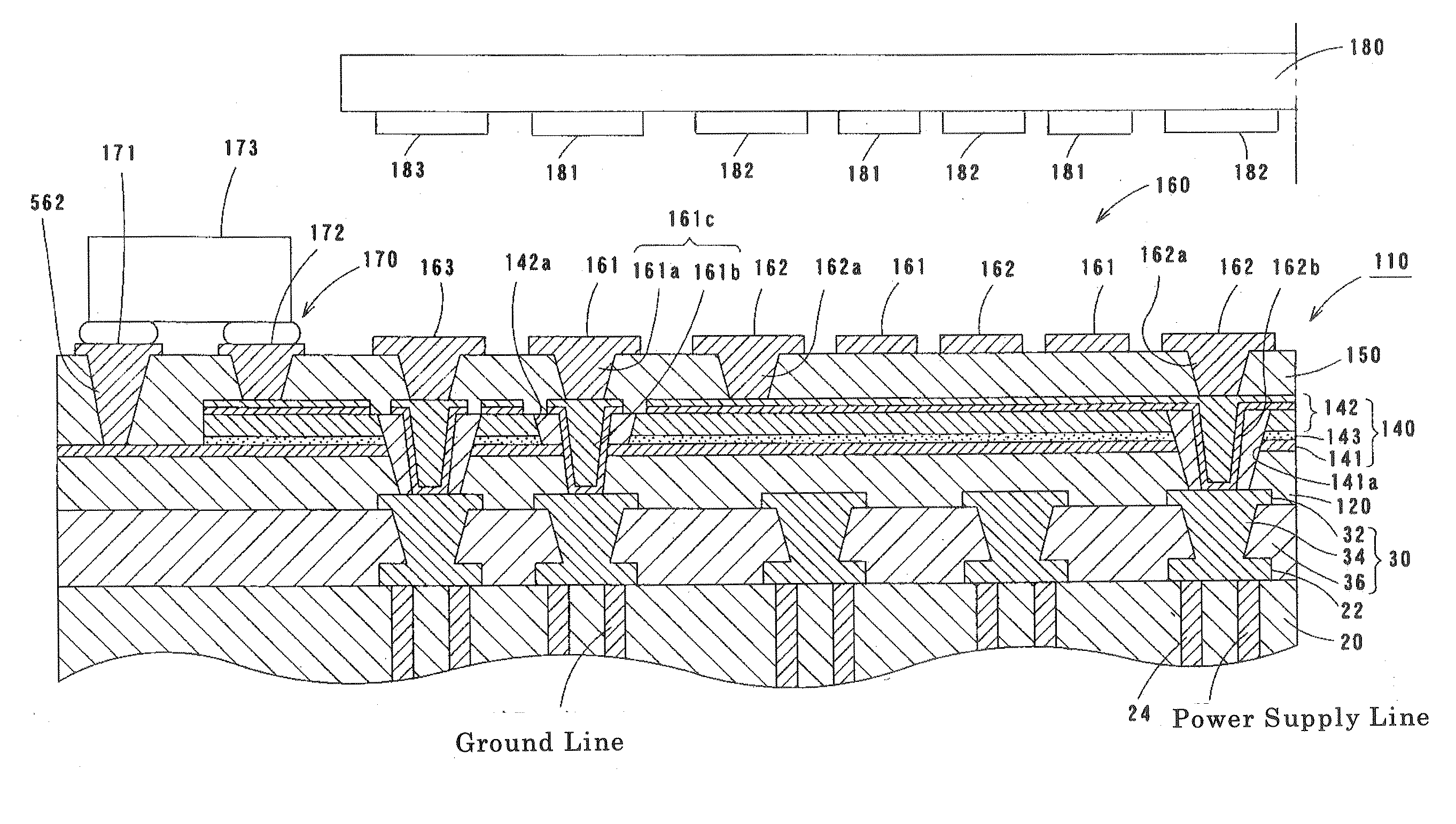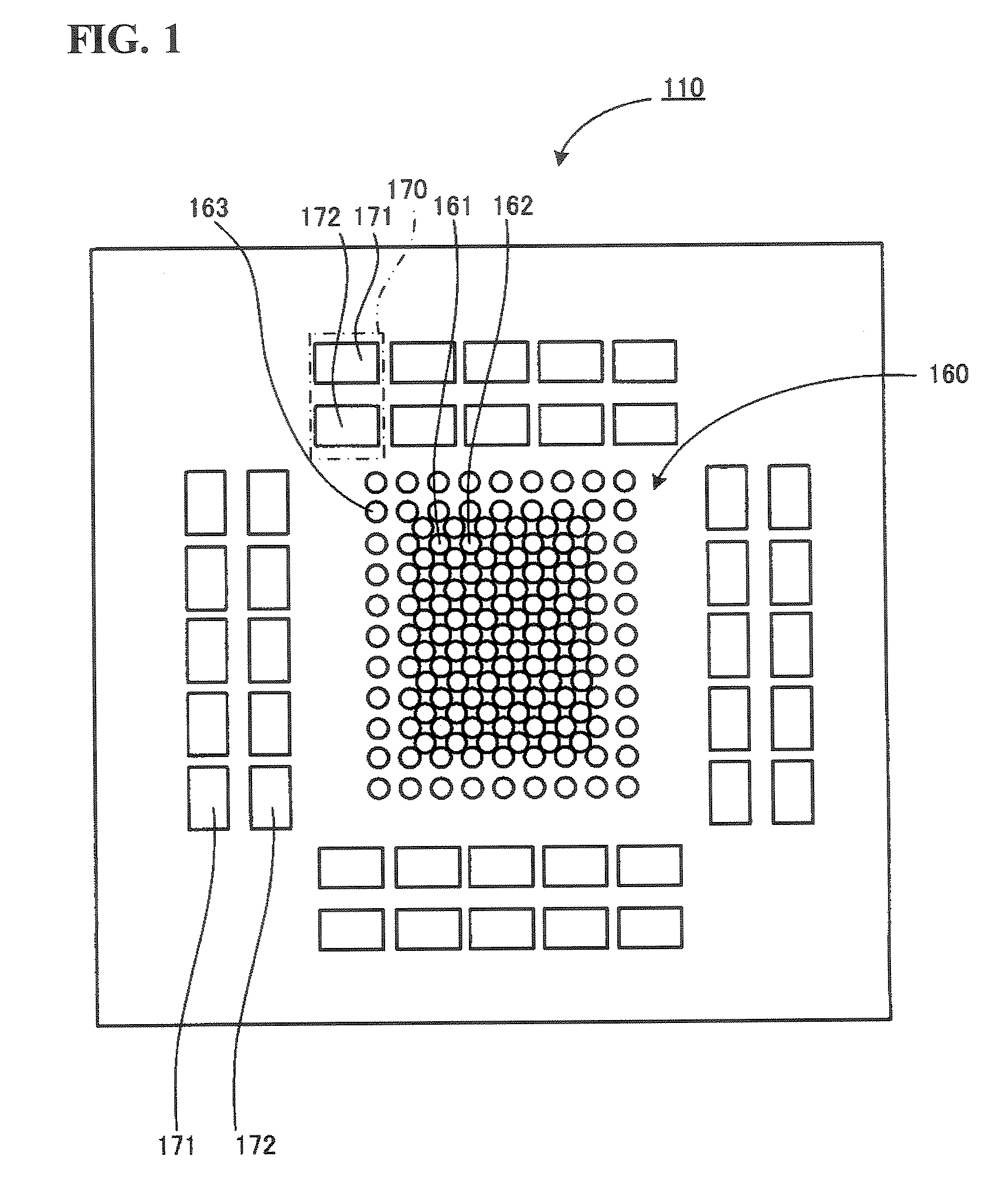Multilayer printed wiring board
- Summary
- Abstract
- Description
- Claims
- Application Information
AI Technical Summary
Benefits of technology
Problems solved by technology
Method used
Image
Examples
first embodiment
[0030]Embodiments of the present invention will now be described with reference to the drawings. FIG. 1 is a plan view of a multilayer printed wiring board 110 according to a first embodiment of the present invention, FIG. 2 is a longitudinal cross-sectional view of the multilayer printed wiring board 110 (which shows only the part to the left of the center line), and FIG. 3 is a schematic perspective view showing a layered capacitor portion 140.
[0031]As shown in FIG. 2, the multilayer printed wiring board 110 of this embodiment includes a core substrate 20 in which wiring patterns 22 provided on the upper surface and the lower surface of the substrate are electrically connected to each other via through-hole conductors 24; a built-up portion 30 in which a plurality of wiring patterns 32 and 22, which are stacked with a resin insulating layer 36 therebetween, are electrically connected through via holes 34, the built-up portion 30 being provided on the upper surface of the core subs...
second embodiment
[0059]FIG. 8 is a longitudinal cross-sectional view of a multilayer printed wiring board 210 (which shows only the part to the left of the center line) according to a second embodiment. As shown in FIG. 8, the multilayer printed wiring board 210 of this embodiment includes a core substrate 20 similar to that of the first embodiment; a built-up portion 30 in which a wiring pattern 22 and a wiring pattern 32, which are stacked with a resin insulating layer 36 therebetween, are electrically connected through via holes 34, the built-up portion 30 being provided on the upper surface of the core substrate 20; an interlayer insulating layer 220 stacked on the built-up portion 30; a layered capacitor portion 240 which is stacked on the interlayer insulating layer 220 and which includes a first layered electrode 241, a second layered electrode 242, and a high-dielectric layer 243 provided between the first layered electrode 241 and the second layered electrode 242; an interlayer insulating l...
experimental examples 1 to 5
[0074]In Experimental Examples 1 to 5, in the first embodiment, the number of times the steps of spin-coating, drying, and sintering of the procedure (4) in the process of preparing the high-dielectric sheet were repeated was four, and a high-dielectric layer 143 having a thickness of 0.12 μm was prepared. By varying the number of second rod-shaped conductors 162b and the number of first rod-shaped conductors 161c of the multilayer printed wiring board 110 shown in FIG. 2 in each experimental example, the ratio of the number of second rod-shaped conductors 162b to the number of power supply pads 162 and the ratio of the number of first rod-shaped conductors 161c to the number of ground pads 161 were controlled as shown in Table 1. Each of the number of power supply pads 162 and the number of ground pads 161 was 10,000. By adjusting the sizes of passing holes 141a and 142a, the capacitance at a position directly under a die of the layered capacitor portion 140 was controlled to 3.8 μ...
PUM
| Property | Measurement | Unit |
|---|---|---|
| Pressure | aaaaa | aaaaa |
| Distance | aaaaa | aaaaa |
| Capacitance | aaaaa | aaaaa |
Abstract
Description
Claims
Application Information
 Login to View More
Login to View More - R&D
- Intellectual Property
- Life Sciences
- Materials
- Tech Scout
- Unparalleled Data Quality
- Higher Quality Content
- 60% Fewer Hallucinations
Browse by: Latest US Patents, China's latest patents, Technical Efficacy Thesaurus, Application Domain, Technology Topic, Popular Technical Reports.
© 2025 PatSnap. All rights reserved.Legal|Privacy policy|Modern Slavery Act Transparency Statement|Sitemap|About US| Contact US: help@patsnap.com



